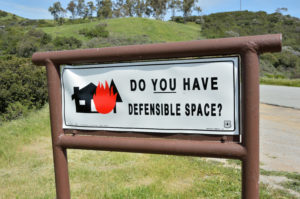 Late last month, Andy Caldwell, frequent environmental critic and bombastic radio talk show host, wrote an op-ed in the Santa Barbara News-Press labeling ForestWatch an “extreme environmental group” and naming some of our Board members in response to the area’s recent wildfires and our unrelated Gaviota fuel break lawsuit filed in 2016. Mr. Caldwell is known for his incendiary guest columns in the publication, many of which have recently blamed the lack of large-scale vegetation removal projects and prescribed burning for the modern wildfires in the region. As his July 27 op-ed (“What’s worse than an infrequent oil spill?”) named ForestWatch specifically, we decided to set the record straight. Below is our column, first published on August 13 in the Santa Barbara News-Press:
Late last month, Andy Caldwell, frequent environmental critic and bombastic radio talk show host, wrote an op-ed in the Santa Barbara News-Press labeling ForestWatch an “extreme environmental group” and naming some of our Board members in response to the area’s recent wildfires and our unrelated Gaviota fuel break lawsuit filed in 2016. Mr. Caldwell is known for his incendiary guest columns in the publication, many of which have recently blamed the lack of large-scale vegetation removal projects and prescribed burning for the modern wildfires in the region. As his July 27 op-ed (“What’s worse than an infrequent oil spill?”) named ForestWatch specifically, we decided to set the record straight. Below is our column, first published on August 13 in the Santa Barbara News-Press:
A Better Way to Protect Communities from Wildfire
by Allan Morton and Jeff Kuyper
Los Padres ForestWatch
To answer Andy Caldwell’s perplexing question – “What’s worse than an infrequent oil spill?” (Guest Opinion, July 27, 2017) – well, there’s nothing worse than using a community tragedy to further one’s own political agenda.
Yet Mr. Caldwell does just that, blaming everyone from local elected officials to “extreme environmental groups” for a string of recent wildfires. Instead of engaging in a rational, fact-based debate, he once again seizes an untimely opportunity to flame his opponents and extinguish any hint of reasonable discourse on a very complex topic.
Let’s first start with Mr. Caldwell’s assertion that current fires “burn too hot.” That’s simply not true. Chaparral has always been shaped by large, high-intensity wildfires driven by winds, high temperatures, low humidity, and vegetation that does what it has always done – burn. Large, hot fires are a normal part of chaparral.
Nor is our native chaparral suffering from a “lack of management and maintenance.” The normal condition of chaparral is dense and impenetrable. Several strategic fuel breaks already exist directly adjacent to communities. Yet Mr. Caldwell wants more prescribed burning (50,000 acres per year, according to another column of his), more fuel break and road construction in remote areas, and more elimination of native chaparral vegetation.
Caldwell’s slash-and-burn scheme would cost hundreds of millions of dollars to implement, and he fails to state how we as taxpayers and homeowners would even begin to pay for it. Leading fire ecologists, including experts with the U.S. Forest Service, the U.S. Geological Survey, and the National Park Service, all agree that widespread manipulation of chaparral is not cost-effective, diverts limited firefighting resources away from where they are needed most, and harms the environment.
Those are the reasons why we challenged a six-mile-long, 300-foot-wide fuel break last year along a remote section of the Gaviota Coast. It would have cost hundreds of thousands of dollars to construct and maintain, without providing any structure protection where its most effective – directly adjacent to communities. The recent Whittier Fire did not even reach the area where the fuel break was proposed.
What the Whittier fire did was jump a pre-existing fuel break along the ridgetop and continued to burn down the front side of the Santa Ynez Mountains. That ridgetop fuel break has existed for decades, was recently maintained, and yet was no match for the wind-driven wildfire that it was designed to stop.
Scientists and firefighters have known for years that the most effective way to protect our homes is by direct structure protection. Reducing vegetation immediately around a structure (“defensible space”) is the single most important act that any landowner can take to protect their property, their lives, and the lives of their loved ones. Constructing and retrofitting homes with fire-safe materials like ignition-resistant roof shingles, screens to prevent ember intrusion in vents and eaves and wood decks, and dual-pane windows to reduce heat intrusion, will also greatly increase the likelihood of your home surviving a wildfire.
It’s a way for us as homeowners to take personal responsibility for our own property, while causing the least environmental harm to our surroundings.
Mr. Caldwell ends his guest commentary by listing the names of some (but not all) of our Board of Directors. This was a curious intimidation tactic. While our Board members are honored to be recognized for their service, their names and backgrounds are no secret – they are all listed on our website at LPFW.org. Our volunteer Board members proudly serve our organization and take their role as stewards of our region’s public lands seriously.
On the other hand, Mr. Caldwell’s organization – COLAB – does not list any of its Board members on its website. Why doesn’t he want the community to know about his organization’s own leadership?
Wildfire – and our community’s response to it – is a serious issue, with significant and very real consequences for the safety of firefighters, our homes, and the environment. Let’s work constructively to understand the facts and find real solutions to the challenges facing our public lands and the communities that rely on them.







Comments are closed.